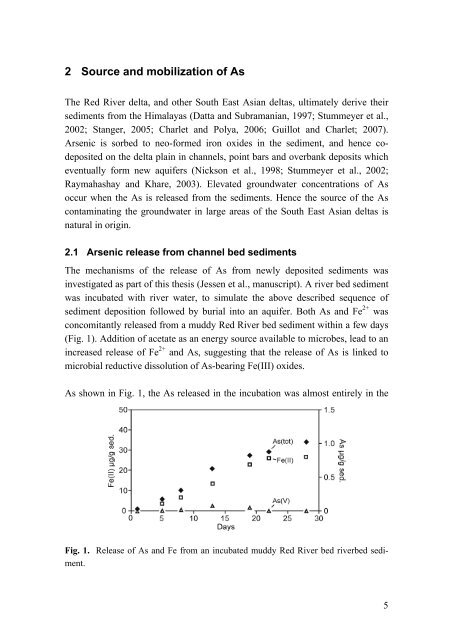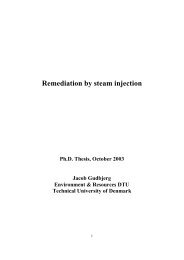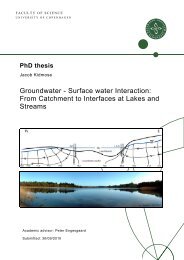Groundwater arsenic in the Red River delta, Vietnam ... - Fiva
Groundwater arsenic in the Red River delta, Vietnam ... - Fiva
Groundwater arsenic in the Red River delta, Vietnam ... - Fiva
You also want an ePaper? Increase the reach of your titles
YUMPU automatically turns print PDFs into web optimized ePapers that Google loves.
2 Source and mobilization of As<br />
The <strong>Red</strong> <strong>River</strong> <strong>delta</strong>, and o<strong>the</strong>r South East Asian <strong>delta</strong>s, ultimately derive <strong>the</strong>ir<br />
sediments from <strong>the</strong> Himalayas (Datta and Subramanian, 1997; Stummeyer et al.,<br />
2002; Stanger, 2005; Charlet and Polya, 2006; Guillot and Charlet; 2007).<br />
Arsenic is sorbed to neo-formed iron oxides <strong>in</strong> <strong>the</strong> sediment, and hence codeposited<br />
on <strong>the</strong> <strong>delta</strong> pla<strong>in</strong> <strong>in</strong> channels, po<strong>in</strong>t bars and overbank deposits which<br />
eventually form new aquifers (Nickson et al., 1998; Stummeyer et al., 2002;<br />
Raymahashay and Khare, 2003). Elevated groundwater concentrations of As<br />
occur when <strong>the</strong> As is released from <strong>the</strong> sediments. Hence <strong>the</strong> source of <strong>the</strong> As<br />
contam<strong>in</strong>at<strong>in</strong>g <strong>the</strong> groundwater <strong>in</strong> large areas of <strong>the</strong> South East Asian <strong>delta</strong>s is<br />
natural <strong>in</strong> orig<strong>in</strong>.<br />
2.1 Arsenic release from channel bed sediments<br />
The mechanisms of <strong>the</strong> release of As from newly deposited sediments was<br />
<strong>in</strong>vestigated as part of this <strong>the</strong>sis (Jessen et al., manuscript). A river bed sediment<br />
was <strong>in</strong>cubated with river water, to simulate <strong>the</strong> above described sequence of<br />
sediment deposition followed by burial <strong>in</strong>to an aquifer. Both As and Fe 2+ was<br />
concomitantly released from a muddy <strong>Red</strong> <strong>River</strong> bed sediment with<strong>in</strong> a few days<br />
(Fig. 1). Addition of acetate as an energy source available to microbes, lead to an<br />
<strong>in</strong>creased release of Fe 2+ and As, suggest<strong>in</strong>g that <strong>the</strong> release of As is l<strong>in</strong>ked to<br />
microbial reductive dissolution of As-bear<strong>in</strong>g Fe(III) oxides.<br />
As shown <strong>in</strong> Fig. 1, <strong>the</strong> As released <strong>in</strong> <strong>the</strong> <strong>in</strong>cubation was almost entirely <strong>in</strong> <strong>the</strong><br />
Fig. 1. Release of As and Fe from an <strong>in</strong>cubated muddy <strong>Red</strong> <strong>River</strong> bed riverbed sediment.<br />
5





